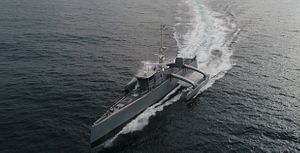The first prototype of an autonomous sub-hunting surface ship, the Office of Naval Research (ONR)’s Medium Displacement Unmanned Surface Vessel (MDUSV), christened Sea Hunter, became the first ship to successfully autonomously navigate from San Diego to Pearl Harbor, Hawaii, and back without a single crew member onboard, defense contractor Leidos announced in a January 31 press release.
During the round trip of more than 8,300 kilometers, personnel from an escort ship boarded the Sea Hunter periodically to check electrical and propulsion systems. It is unclear whether the submarine-hunting catamaran-style drone ship had to undergo any repairs while at sea. It is also unclear how long it took the autonomous ship to complete the round trip across the Pacific Ocean. The Sea Hunter reportedly arrived in Hawaii at the end of October 2018.
“The Sea Hunter program is leading the world in unmanned, fully autonomous naval ship design and production,” said Gerry Fasano, Leidos Defense Group President. Leidos is coordinating the MDUSV project for the U.S. Navy. “The recent long-range mission is the first of its kind and demonstrates to the U.S. Navy that autonomy technology is ready to move from the developmental and experimental stages to advanced mission testing.”
U.S. Defense Advanced Research Projects Agency (DARPA) – a Pentagon organization responsible for developing emerging technologies for the U.S. military’s use — handed over the Sea Hunter to the U.S. Navy in January 2018, marking the end of DARPA’s Anti-Submarine Warfare Continuous Trail Unmanned Vessel (ACTUV) program.
DARPA originally initiated the ACTUV program in 2010. In 2014, DARPA joined force with ONR to jointly fund a test phase for the ACTUV prototype, with Leidos building the ship’s navigation system and Oregon-based Vigor Works overseeing overall construction. The ship was christened in April 2016 and subsequently underwent open-water trials, which included testing the prototype’s long-range tracking capabilities. Tests also included tracking a submarine from 1 kilometer away, as well as deploying a mine countermeasures payload.
As I explained last February:
Capable of reaching top speeds of up 27 knots, the 132-feet (40 meters) long and 140-ton heavy unmanned autonomous MDSUV trimaran prototype is designed to operate autonomously for 60 to 90 days straight, surveil large stretches of ocean territory and — should an enemy submarine be detected — guide U.S. Navy warships or aircraft to the sub’s location to destroy it (the Sea Hunter does not carry any weapons systems).
The robot ship reportedly uses a fifth-generation medium-frequency hull-mounted sonar system to conduct active and passive sonar searches. DARPA has also been working on developing non-conventional sensor technologies to enable the correct identification of surface ships and other objects while at sea.
The U.S. Navy reportedly awarded Leidos a potential $43.5 million contract to develop a second drone ship, tentatively designated Sea Hunter II, which is currently under construction at a shipyard in Mississippi. According to Leidos, the sister ship will incorporate lessons learned during the first Sea Hunter build, evolving mission requirements, and further development of autonomy features.

































